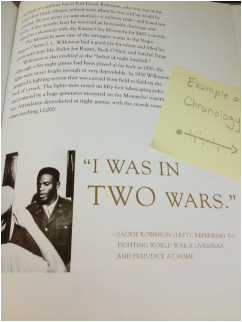
Here’s how we used it this week. I was working with students on
CCS RI.4.5. Describe the overall structure (e.g., chronology, comparison, cause/effect, problem/solution) of events, ideas, concepts, or information in a text or part of a text.
After students had a solid understanding of the different types of informational text, they were each given several sticky notes. At the top of each they were directed to write “Example of _______,” filling in the text type name. Underneath, they drew a visual representation that might aid their comprehension or note taking. For example, underneath “Example of Compare/Contrast” might be a Venn Diagram.
Students were then given time to wander the classroom, looking for informational texts. As they browsed a text, they looked for a page on which they could stick their note, showing a good example of that text type. These sticky notes will be left in the books until next year, when new students will come across them as they explore books. This will expose the new students to the concepts and vocabulary in real contexts.
Pay it Forward Post-Its can be used in a variety of content areas. For example, students in a math class could place sticky notes in their math texts that identify certain types of problem solving (i.e. decomposition.) Students in social studies could place sticky notes that identify specific types of conflict (i.e. territorial.) Next year’s students will have a head start on understanding these concepts by occasionally coming across these notes, and this year's students have an opportunity to reinforce their current understanding before heading off on vacation. A win-win!

 RSS Feed
RSS Feed